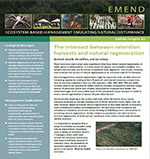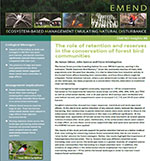EMEND Insights
'EMEND Insights' is a series of brief, bite size bits of information designed to close the loop between research and implementation.



Click on the links below to read about our recent findings at EMEND.
- EMEND Insights #1: The intersect between retention harvests and natural regeneration
- EMEND Insights #2: Gatekeepers of the forest: the ichneumonids of EMEND
- EMEND Insights #3: Spider response to variable retention harvesting: Biodivserity lessons learned from the EMEND project
- EMEND Insights #4: Large retention patches support moth biodiversity
- EMEND Insights #5: Life after death: The importance of deadwood for beetles in the boreal forest
- EMEND Insights #6: The role of retention and reserves in the conservation of forest bird communities
- EMEND Insights #7: Bumble bees and cut-blocks: how harvesting affects forest pollinators
- EMEND Insights #8: Using ecosite classification to predict beetle diversity and key habitats for uncommon species
- EMEND Insights #9: Retention patch size influences saproxylic beetle conservation in White spruce stands
- EMEND Insights #10: Gastropods: Slugging away at the ecology of a little known forest animal
- EMEND Insights #11: Seeing the forest for the snags: managing coarse woody debris in harvested landscapes
- EMEND Insights #12: Dispersed retention improves the conservation value of small retention patches
- EMEND Insights #13: Sources and sinks: soil carbon dynamics are affected by disturbance type and stand composition
- EMEND Insights #14: Seeing the forest through new eyes: using remote sensing data to understand forest responses to variable retention harvesting
- EMEND Insights #15: Identifying high-quality wood frog breeding wetlands for protection during harvest
- EMEND Insights #16: Designing harvests to increase survival of retention trees
- EMEND Insights #17: Dispersed retention improves the conservation value of retention patches for plants
- EMEND Insights #18:Using Wet Areas Mapping to plan retention placement: Lessons from the understory
- EMEND Insights #19:Who lives where?Responses to forestry by cavity-nesting owls
- EMEND Insights #20:Benefits of green-tree retention for ground beetles take time
- EMEND Insights #21:Using Wet Areas Mapping to plan retention for bryophytes
- EMEND Insights #22: Adapting harvest practices to climate change: how Wet Areas Mapping can estimate soil carbon stock
- EMEND Insights #23: Using a topographic wetness index to information forest retention design
EMEND Infographics:
- EMEND Biodiversity: Retention harvesting impacts on biodiversity
- EMEND and WAM #1: Wet Areas Mapping and retention harvesting - overview
- EMEND and WAM #2: Using WAM to inform placement of retention
In 2010, we also worked with the Sustainable Forest Management Network to produce a series of briefing notes on EMEND research. Click on the links below to read these brief documents that help link research to on the ground practices.
- Research Note #74: Retention patch sizes and biodiversity conservation
- Research Note #72: The importance of small canopy patches for understory plants
- Research Note #70: EMEND soils – Lessons learned so far
- Research Note #65: Understory plant response to variable retention harvesting
- Research Note #63: Variable retention harvesting and bryophytes
- Research Note #42: Deadwood and insects at EMEND
- Research Note #41: Silviculture findings from EMEND
